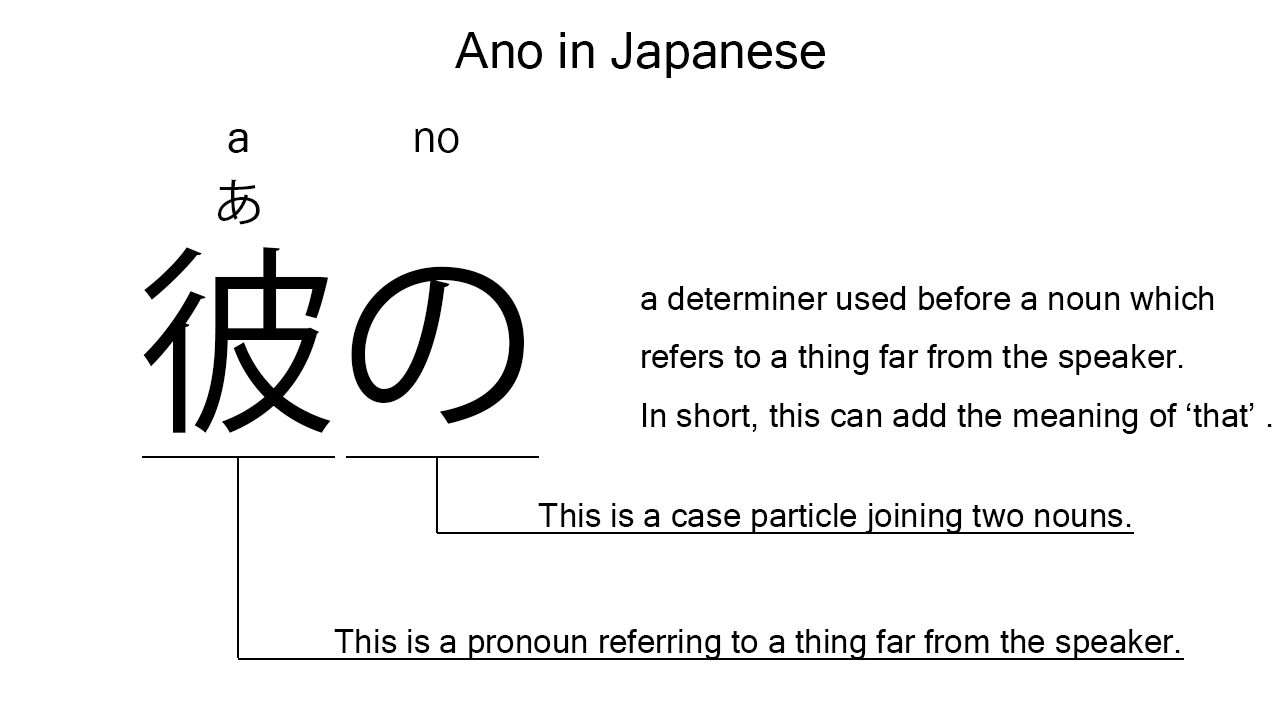What does “ano” mean in Japanese?
Native speakers often use “ano” as a determiner to add the meaning of ‘that’ in Japanese. Perhaps, some Japanese learners know this word as it is sometimes used in Japanese conversations. In this blog post, however, I will explain this word in detail together with its kanji expression. And also, I will explain how to use it through example sentences. My explanations would help Japanese learners understand “ano” more clearly. Then, let’s get started!
Contents
Definition and meaning of “ano”
Let me start with the definition and meaning of “ano”.
- ano – あの : a determiner used in front of a noun which refers to a thing far from both the speaker and the listener.
Japanese native speakers use this determiner in front of a noun to refer to a thing far from them. Its role is very similar to that of the English determiner, “that”, I think.
This determiner is normally written in hiragana, but can be written in kanji too. Interestingly, its kanji expression helps us understand the concept more clearly, so let me explain it in detail.
Ano in kanji
The kanji expression of “ano” consists of the following two characters:
- 彼 : a kanji character used as a pronoun to refer to a thing far from both the speaker and the listener.
- の : a case particle joining two nouns or noun equivalent words. Normally, the first one can work as a modifier to describe the second. In this case, this works after “彼” to change it to a modifier which means ‘that’ in Japanese.
These two characters tell us that the formed determiner literally means ‘that’ in Japanese. This literal interpretation is completely in line with the actual meaning and role.

So far, I’ve explained the definition and meaning of “ano” together with its kanji expression. Then, let me explain how to use it through the example sentences below.
Example #1: how to use “ano”
ano chou wa totemo utsukushii – あの蝶はとても美しい (あのちょうはとてもうつくしい)
That butterfly is very beautiful.
Below are the new words used in the example sentence.
- chou – 蝶 (ちょう) : a noun meaning ‘butterfly’ in Japanese. This can also work as plural. Learn more about Japanese plural.
- wa – は : a binding particle working as a case marker or topic marker. In the example, this works after “ano chou” to make the subject in the sentence.
- totemo – とても : an adverb of degree meaning ‘very’, ‘much’, ‘so’, or such in Japanese. In the example, this works in front of “utsukushii” to emphasize its meaning.
- utsukushii – 美しい (うつくしい) : an i-adjective meaning ‘beautiful’ in Japanese.
This is a typical usage of “ano”. In this example, it works in front of “chou” to say “that butterfly” in Japanese.
Example #2: another usage of “ano”
ano on’nanoko wa watashi no musume desu – あの女の子は私の娘です (あのおんなのこはわたしのむすめです)
That girl is my daughter.
Below are the new words used in the example sentence.
- on’nanoko – 女の子 (おんなのこ) : a noun meaning ‘girl’ in Japanese. This can also work as plural.
- watashi – 私 (わたし) : a pronoun meaning ‘I’ in Japanese.
- no – の : a case particle used after a noun or pronoun to make its possessive case. In the example, this is used after “watashi” to make its possessive case, “watashi no“, which means ‘my’ in Japanese.
- musume – 娘 (むすめ) : a noun meaning ‘daughter’ in Japanese. This can also work as plural.
- desu – です : an auxiliary verb used after a noun or adjective to make it polite. Probably, this is well known as a part of Japanese desu form. In the example, this is used after “watashi no musume” to make it sound polite.
This is another typical usage of “ano”. In this example, it works in front of the noun, “on’nanoko”, to say “that girl” in Japanese. Anyway, when we want to use a determiner to add the meaning of ‘that’ in Japanese, “ano” is always a very good option.
Summary
In this blog post, I’ve explained the definition and meaning of “ano” in detail together with its kanji expression. And also, I’ve explained how to use it through the example sentences. Let me summarize them as follows.
- ano – あの : a determiner used in front of a noun which refers to a thing far from both the speaker and the listener. Native speakers normally use this determiner in front of a noun to add the meaning of ‘that’ in Japanese. The role is very similar to that of the English determiner, “that”, I think. This is normally written in hiragana, but can be written in kanji too. The kanji expression is “彼の”. The first character is a pronoun which refers to a thing far from both the speaker and the listener; the second is a case particle which changes its preceding word to a modifier. So, the kanji expression is literally a determiner which means ‘that’ in Japanese.
Hope my explanations are understandable and helpful for Japanese learners.